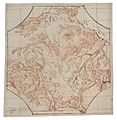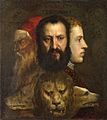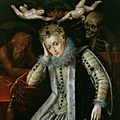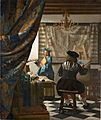Allegory facts for kids
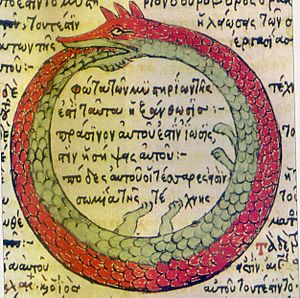
An allegory is a story, poem, or picture that has a hidden meaning. It uses symbols to represent ideas or qualities. This means an allegory has a deeper, figurative meaning, not just a simple, literal one.
Allegories can be found in many forms. They can be stories in books or poems. They can also be things you look at, like a painting or sculpture.
An allegory is a bit like a long metaphor. You need to use your imagination to understand its hidden message. A fable or a parable is a short type of allegory. These often have one main idea or a moral lesson.
Sometimes, people think a story is an allegory when the author didn't mean it to be. For example, some people thought The Lord of the Rings was an allegory for the World Wars. But the author, J.R.R. Tolkien, said it was not. He wrote it before World War II even started. This shows how people can sometimes add their own meanings to a story.
Contents
Why Allegories Are Used
Allegories have been popular in literature for a long time. They are often used to talk about things or people indirectly. This can be helpful when it's not possible to criticize something directly.
Allegories Today
Allegories are still very popular even now. You can find them in pictures, movies, and plays.
Famous Allegories in Literature
- William Golding’s novel Lord of the Flies has a hidden allegorical meaning. It explores human nature and society.
- The TV show Star Trek often used allegory. It looked at social issues and moral values of its time. It did this by telling stories set in the future. Alien races in the show often reflected Earth's own cultures and countries.
Allegories in Art
Many famous artworks are allegories.
- Sandro Botticelli's La Primavera (Allegory of Spring) is a well-known example.
- Jan Vermeer's The Allegory of Painting also tells a deeper story through its images.
Related pages
Images for kids
-
Pearl, miniature from Cotton Nero A.x. The Dreamer stands on the other side of the stream from the Pearl-maiden. Pearl is one of the greatest allegories from the High Middle Ages.
-
Albrecht Dürer, Melencolia I (1514): Unused tools, an hourglass, an empty scale surround a female personification, with other esoteric and exoteric symbols.
-
Titian, Allegory of Prudence (c. 1565–1570): The three human heads symbolise past, present and future, the characterisation of which is furthered by the triple-headed beast (wolf, lion, dog), girded by the body of a big snake.
-
The English School's Allegory of Queen Elizabeth (c. 1610), with Father Time at her right and Death looking over her left shoulder. Two cherubs are removing the weighty crown from her tired head.
-
Artemisia Gentileschi, Self-Portrait as the Allegory of Painting (c. 1638–39)
-
Jan Vermeer, The Art of Painting (c. 1666): Painting is shown as related to history and politics, the young woman being Clio, the muse of history, and other symbols for the political and religious division of the Netherlands appearing.
-
Flemish August Bouttats, Allegory of Triumphant Spain with immaculist banner, ca. 1682, cover of Triumphant Spain and the laureate church all over the world by the patronage of Holy Mary, Collection: Hispanic Society of America
See also
 In Spanish: Alegoría para niños
In Spanish: Alegoría para niños




